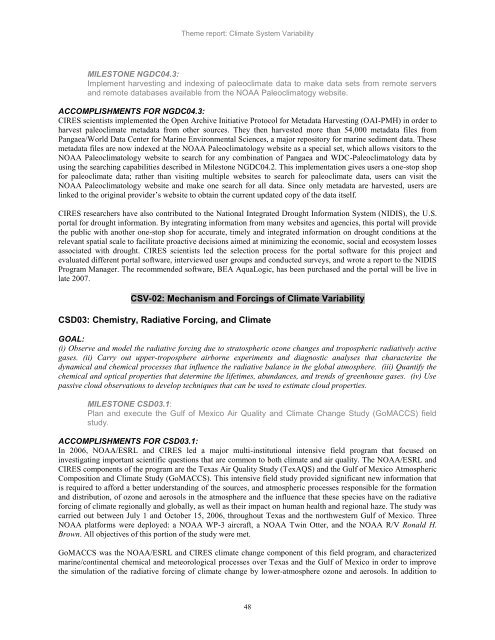Scientific Theme: Advanced Modeling and Observing Systems
Scientific Theme: Advanced Modeling and Observing Systems
Scientific Theme: Advanced Modeling and Observing Systems
You also want an ePaper? Increase the reach of your titles
YUMPU automatically turns print PDFs into web optimized ePapers that Google loves.
<strong>Theme</strong> report: Climate System Variability<br />
MILESTONE NGDC04.3:<br />
Implement harvesting <strong>and</strong> indexing of paleoclimate data to make data sets from remote servers<br />
<strong>and</strong> remote databases available from the NOAA Paleoclimatogy website.<br />
ACCOMPLISHMENTS FOR NGDC04.3:<br />
CIRES scientists implemented the Open Archive Initiative Protocol for Metadata Harvesting (OAI-PMH) in order to<br />
harvest paleoclimate metadata from other sources. They then harvested more than 54,000 metadata files from<br />
Pangaea/World Data Center for Marine Environmental Sciences, a major repository for marine sediment data. These<br />
metadata files are now indexed at the NOAA Paleoclimatology website as a special set, which allows visitors to the<br />
NOAA Paleoclimatology website to search for any combination of Pangaea <strong>and</strong> WDC-Paleoclimatology data by<br />
using the searching capabilities described in Milestone NGDC04.2. This implementation gives users a one-stop shop<br />
for paleoclimate data; rather than visiting multiple websites to search for paleoclimate data, users can visit the<br />
NOAA Paleoclimatology website <strong>and</strong> make one search for all data. Since only metadata are harvested, users are<br />
linked to the original provider‘s website to obtain the current updated copy of the data itself.<br />
CIRES researchers have also contributed to the National Integrated Drought Information System (NIDIS), the U.S.<br />
portal for drought information. By integrating information from many websites <strong>and</strong> agencies, this portal will provide<br />
the public with another one-stop shop for accurate, timely <strong>and</strong> integrated information on drought conditions at the<br />
relevant spatial scale to facilitate proactive decisions aimed at minimizing the economic, social <strong>and</strong> ecosystem losses<br />
associated with drought. CIRES scientists led the selection process for the portal software for this project <strong>and</strong><br />
evaluated different portal software, interviewed user groups <strong>and</strong> conducted surveys, <strong>and</strong> wrote a report to the NIDIS<br />
Program Manager. The recommended software, BEA AquaLogic, has been purchased <strong>and</strong> the portal will be live in<br />
late 2007.<br />
CSV-02: Mechanism <strong>and</strong> Forcings of Climate Variability<br />
CSD03: Chemistry, Radiative Forcing, <strong>and</strong> Climate<br />
GOAL:<br />
(i) Observe <strong>and</strong> model the radiative forcing due to stratospheric ozone changes <strong>and</strong> tropospheric radiatively active<br />
gases. (ii) Carry out upper-troposphere airborne experiments <strong>and</strong> diagnostic analyses that characterize the<br />
dynamical <strong>and</strong> chemical processes that influence the radiative balance in the global atmosphere. (iii) Quantify the<br />
chemical <strong>and</strong> optical properties that determine the lifetimes, abundances, <strong>and</strong> trends of greenhouse gases. (iv) Use<br />
passive cloud observations to develop techniques that can be used to estimate cloud properties.<br />
MILESTONE CSD03.1:<br />
Plan <strong>and</strong> execute the Gulf of Mexico Air Quality <strong>and</strong> Climate Change Study (GoMACCS) field<br />
study.<br />
ACCOMPLISHMENTS FOR CSD03.1:<br />
In 2006, NOAA/ESRL <strong>and</strong> CIRES led a major multi-institutional intensive field program that focused on<br />
investigating important scientific questions that are common to both climate <strong>and</strong> air quality. The NOAA/ESRL <strong>and</strong><br />
CIRES components of the program are the Texas Air Quality Study (TexAQS) <strong>and</strong> the Gulf of Mexico Atmospheric<br />
Composition <strong>and</strong> Climate Study (GoMACCS). This intensive field study provided significant new information that<br />
is required to afford a better underst<strong>and</strong>ing of the sources, <strong>and</strong> atmospheric processes responsible for the formation<br />
<strong>and</strong> distribution, of ozone <strong>and</strong> aerosols in the atmosphere <strong>and</strong> the influence that these species have on the radiative<br />
forcing of climate regionally <strong>and</strong> globally, as well as their impact on human health <strong>and</strong> regional haze. The study was<br />
carried out between July 1 <strong>and</strong> October 15, 2006, throughout Texas <strong>and</strong> the northwestern Gulf of Mexico. Three<br />
NOAA platforms were deployed: a NOAA WP-3 aircraft, a NOAA Twin Otter, <strong>and</strong> the NOAA R/V Ronald H.<br />
Brown. All objectives of this portion of the study were met.<br />
GoMACCS was the NOAA/ESRL <strong>and</strong> CIRES climate change component of this field program, <strong>and</strong> characterized<br />
marine/continental chemical <strong>and</strong> meteorological processes over Texas <strong>and</strong> the Gulf of Mexico in order to improve<br />
the simulation of the radiative forcing of climate change by lower-atmosphere ozone <strong>and</strong> aerosols. In addition to<br />
48
















